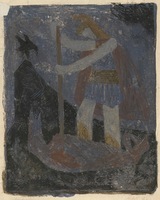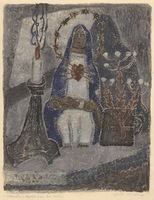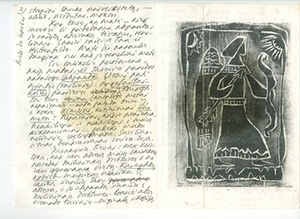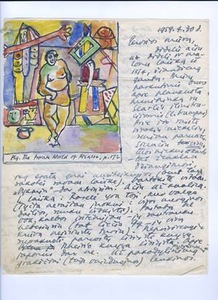Correspondence with brother: epistolary friendship and art studies 0
In brief: The Lithuanian graphic artist and teacher Elena Jakutytė was born on November 28, 1911 in Buchara, Uzbekistan. After the family of Elena returned to Lithuania, World War I started and the artist was forced to leave for Russia. After returning to Lithuania again, Elena studied in Mažeikiai, later in Kaunas. At the end of World War II E.Jakutytė decided to study graphic arts. In 1944-1950 she studied at Kaunas State Applied and Decorative Art Institute (specialty of graphic arts). After graduation she was appointed to work at Kaunas Secondary Art School, in which she raised several generations of contemporary artists in two decades of her work (1950-1970). The graphic artist is well remembered not only by her former students: graphic artist Petras Repšys, painter Laima Drazdauskaitė, architect Vidmandas Miliūnas, graphic artist Alina Meškauskaitė-Kvedarauskienė, museologist Stasys Urbonas, painter Povilas Ričardas Vaitiekūnas and others but also by colleagues and other artists of Kaunas – graphic artist Romualdas Čarna, sculptor Leonas Strioga.
All 4 works are property of the National M. K. Čiurlionis Art Museum.
Even though only one solo exhibition was organised during the life of the artist (in 1964 in Kaunas and Vilnius), the majority of art admirers could admirer her works in group exhibitions. Elena did not have a workshop and created works in her living room by hand. She was very accurate, used many techniques, loved soft shades. Her works may be understood knowing modernists of Western Europe and Lithuanian inter-war paintings.
Elena was an intellectual and noble woman. Her biggest spiritual joy and purposeful free time were letters and books from Australia sent by her brother. The artist died on Mach 9, 1999. Former students organised the retrospective 100th anniversary exhibition of Elena Jakutytė in 2011.
* * *
Extract from the text of the album of the graphic artist and teacher Elena Jakutytė (1911-1999) that will be published soon. The presentation of the album is planned in Kaunas and Vilnius in autumn of 2013.
Vladas Jakutis and his family moved to the West from Kaunas due to the change of political order in 1944 – first he moved to Germany and later to Austria in 1949. After 1949 the brother of Elena Jakutytė started writing letters to his sister and mother who stayed in Lithuania (the oldest letters are dated the sixth decade). From that time the constant correspondence of the sister and brother started. Their intellectual epistolary friendship lasted for more than 40 years.
Letters of Vladas Jakutis to Elena, 2 examples. Scanned by Andrius Lipšys, from archive of A. Lipšys.
The story of letters of this family is important to art researchers not only from the factological point of view but also by the wider aspect. The letters were often about the world art tendencies and Lithuanian art.
Many texts written by the brother have remained – long texts written in various directions with black-and-white and colour photographs, attached drawings, graphic prints, cut-outs from magazines and newspapers, caricatures and decorative ornaments in the middle of the text.
Vladas loved translating full pages from English art albums and books to Elena: texts about Vincent Van Gogh, Pablo Picasso, Salvador Dali, Henri Rousseau, Rembrandt and other painters written by him have remained.
Letters of Vladas Jakutis to Elena, 2 examples. Scanned by Andrius Lipšys, from archive of A. Lipšys.
The brother was interested in all creative achievements of his sister, he questioned about the organised exhibitions, sent letters with reprinted works of the artist.
This correspondence with the brother filled the free time of Elena and was the biggest spiritual joy for the artist. Letters were more than formality to the artist. It is possible to find cut out photos from newspapers, headings and separate words among documents of Elena Jakutytė – perhaps they could be used in letters. Or perhaps Elena could not read any text offhandedly – without making notes, underlining things important to her. She stood out by accuracy, diligence and liking to perfect text and did the same with her graphic sheets too.















